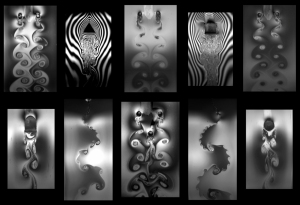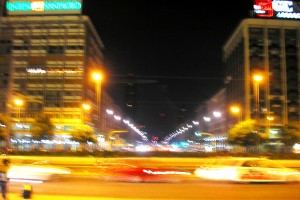Category Archives: Physics
1960s music was original, modern music all sounds the same – the scientific proof
 Painstaking research led by Spanish scientists has produced a set of results to support the argument that music from the 1960s was at its greatest, and modern music is repetitive and unoriginal. The scientists produced these results by analysing information from a database named the Million Song Dataset, which contained data of over a million songs recorded since 1955.
Painstaking research led by Spanish scientists has produced a set of results to support the argument that music from the 1960s was at its greatest, and modern music is repetitive and unoriginal. The scientists produced these results by analysing information from a database named the Million Song Dataset, which contained data of over a million songs recorded since 1955.
Elements of the music such as tempo, volume, timbre, and pitch of notes yielded the above graph, which is a chart of “timbral variety” against time. In other words, it illustrates the diversity of sound in music, and clearly demonstrates that the 1960s was the peak of “timbral variety” in modern musical history. This suggests that music was at its most inventive, creative, and diverse during that era.
Since the 1970s, the originality and diversity of music has been on a downward slide – and continues to dip. These findings suggest that today’s music is simply becoming more and more homogeneous. Fans of 1960s music with a particular hatred for modern artists will revel in this discovery, and see it as undeniable proof that the likes of Justin Beiber and Lady Gaga simply cannot compete with The Beatles, The Rolling Stones, and so forth.
But, argues Sean Carroll of Discover Magazine: “On the other hand, one could … argue that this is because back then we didn’t know how to do it right, and there was a lot of experimental crap, whereas we’ve now figured it out.”
Full story: DISCOVER Magazine http://blogs.discovermagazine.com/cosmicvariance/2012/07/28/music-was-better-in-the-sixties-man/
Women may be able to see more colours than men, say researchers
Humans have the ability to recognise and perceive more than one million different colours. Our eyes are organs that capture light bouncing off objects and project an (upside-down) image onto the retina. These images are then sent to the brain, which is then able to interpret objects, shapes, and colours.
The brain does all the hard work when it comes to seeing things, but the eyes themselves determine colours for us. The fact we can see any colour at all is due to cells in our retinas called cone cells. There are three different types of “cone” at the back of our eyeballs, each able to distinguish 100 shades. All we need to do is open our eyes, and the three types of cone automatically work together to form combinations of shades, deliver these messages to the brain via the optic nerve, and we see colours.
One million is an incredible amount of colours that the eyes can distinguish, purely by shade-detecting cells converting scattered light into electromagnetic impulses. However, neuroscientists at Newcastle University believe that there may be women living amonst us who naturally have “super-human” vision, able to see a hundred times more colours than men.
Why should this be? Well, colour blindness is a consequence of mutations in genes that determine cone cells. Since many of these genes occur in the X chromosome, it means that colour blindness is much more common among males than females. However, a side-effect of this could be that a small percentage of women may actually be born with four colour cones instead of three. This would give their eyes the potential to see one hundred million colours instead of just one millon.
Full story: IO9 Science http://io9.com/5919311/some-women-may-perceive-millions-more-colors-than-the-rest-of-us-are-you-one-of-them?tag=science
American firm proposes “Zero Gravity Roller Coaster”
Anyone familiar with Alton Towers or Thorpe Park will know that roller coasters are awesome. But now, BRC Imagination Arts, a Californian design firm, has proposed a roller coaster sure to eclipse any theme park experience.
It is a ride which will accelerate passengers at such magnitude that they will become “weightless” for a whole eight seconds. BRC drew inspiration from NASA’s “Vomit Comet”, the aeroplane which is used to acclimatise astronauts to the sensation of being in outer space.
Their roller coaster will achieve the same effect by accelerating up to top speed, over 100 mph, on a vertical track, and then suddenly starting to decelerate. This will throw passengers out of their seats, and then the ride will adjust its speed so that it matches the velocity of the passengers. Upon reaching the peak of the track and descending, the roller coaster will continue to match the speed of its falling passengers, prolonging the feeling of weighlessness for several seconds.
It is perhaps the closest thing you can come to experiencing being in outer space without needing to be an astronaut.
Bob Rogers, BRC’s founder and chief creative officer, says the zero-gravity ride would cost $50 million or more, mainly due to the complexity of the precision-response propulsion system. It is still only a concept at this stage, but, if the company could acquire the necessary funds, Rogers claims that this will become a reality by the end of 2013.
Full story: POPSCI http://www.popsci.com/cars/article/2012-01/zero-gravity-roller-coaster
Isaac Newton’s handwritten manuscripts to be published online
 Handwritten work by Sir Isaac Newton is being made available to view on the internet for the very first time. Cambridge University has so far digitised over 4,000 pages of Newton’s work – but that is still only around one-fifth of the contents of Newton’s university archive. The university is publishing pages from his college notebook, as well as annotated drafts from his masterpiece, the Principia Mathematica.
Handwritten work by Sir Isaac Newton is being made available to view on the internet for the very first time. Cambridge University has so far digitised over 4,000 pages of Newton’s work – but that is still only around one-fifth of the contents of Newton’s university archive. The university is publishing pages from his college notebook, as well as annotated drafts from his masterpiece, the Principia Mathematica.
This is all part of a project called Cambridge Digital Library, which will make public the works of great scientists. Figures such as Darwin and Rutherford shall also have their manuscripts put online in due course for the world to see.
Writing on the Digital Library’s webpage, Cambridge University Librarian Anne Jarvis says: “Cambridge University Library contains evidence of some of the greatest ideas and discoveries over two millennia. We want to make our collections accessible to anyone, anywhere in the world with an internet connection and a thirst for knowledge.”
Full story: Guardian http://www.guardian.co.uk/science/2011/dec/12/isaac-newton-principia-mathematica
Digital Library official page: http://cudl.lib.cam.ac.uk/
CERN scientists prepared to retry neutrino experiments; Jim Al-Khalili prepared to eat boxer shorts
 We reported on this blog last month that the laws of Physics had apparently been broken, as scientists at CERN had seemed to make neutrinos travel faster than the speed of light. Einstein’s theory of relativity – along with our entire understanding of the Universe – would have to be completely re-written.
We reported on this blog last month that the laws of Physics had apparently been broken, as scientists at CERN had seemed to make neutrinos travel faster than the speed of light. Einstein’s theory of relativity – along with our entire understanding of the Universe – would have to be completely re-written.
This has turned out to be a controversial and unpopular finding; the validity and reliability of the test have been heavily questioned by Physicists. It is for this reason that the scientists at CERN are set to fine-tune and repeat the test, to make sure they haven’t just made a mistake.
In the original test, a beam of neutrinos were sent on a 720km underground journey from Geneva to San Grasso, and were recorded to turn up sixty-billionths of a second faster than a beam of light would have done. This led to the conclusion that the speed of light (the speed limit of the Universe) had been broken.
Professor Jim Al-Khalili, Physicist and TV presenter (pictured left), believes the result is an error and will be proved wrong. Summing up the general attitude of Physicists everywhere, he confidently announced to the media: “If the Cern experiment proves to be correct and neutrinos have broken the speed of light, I will eat my boxer shorts on live TV.”
The test is scheduled to be repeated before the end of this year. This gives the CERN scientists time to refine their method and calculations, and (as expected by many) conclude that neutrinos cannot travel faster than light. It also gives Professor Al-Khalili some time to invest in some chocolate boxer shorts, just in case.
Full story: The Guardian http://www.guardian.co.uk/science/2011/oct/28/physicists-check-neutrinos-faster-light?CMP=twt_iph
Did soap bubbles ever look so beautiful?
Here is a photograph that has been circulating the science news in the last couple of days, simply because it is so unusual, so intriguing, and so beautiful.
It is a photo from a research paper titled Visualization of flow patterns past various objects in two-dimensional flow using soap film. The researchers point out that a simple soap bubble is possibly the most powerful and effective medium when it comes to researching fluid dynamics.
The authors explain: “Although many advanced experimental flow visualizations, such as particle image velocimetry or laser Doppler velocimetry, have been developed and used in fluid dynamics research, the use of flowing soap films has remained as an educational tool and economical visualization technique to study fluid-structure interaction and hydrodynamic instability in two-dimensional fluid flows. Making use of the optical properties of the soap film and high-speed photography, the wake evolution and vortex patterns behind different bodies can be tracked and captured.”
This photograph is – as many writers and bloggers have noted – “a beautiful reminder that Physics is everywhere, even in soap”.
To see a large version of the photo, in very high resolution, click here: http://cache.gawker.com/assets/images/io9/2011/10/soapfilmsbest.jpg
Many people may want to use this as desktop wallpaper.
Neutrinos appear to break speed limit of Universe
The laws of Physics have been broken. At least, that is the apparent result of experiments at Cern, where subatomic particles seem to have travelled faster than the speed of light.
The speed of light (3oo million metres per second, or 671 million miles an hour) is the speed limit of the Universe. A fundamental law of nature is that nothing can possibly exceed such a velocity. And yet, in a 732-kilometre journey from Cern to the San Grasso Laboratory, tiny neutrinos have recently seemed to do just that – by turning up a fraction of a second too soon.
The researchers behind this seemingly surreal discovery have been quick to point out that these results will be treated cautiously, and more tests would need to be carried out to confirm its validity. Nevertheless, Einstein’s equations, modern Physics, and our understanding of reality could end up being turned completely on its head.
Full story: BBC News http://www.bbc.co.uk/news/science-environment-15017484
Introducing Robonaut R2: The robot that uses Twitter. In outer space.
R2 is a robot with a difference. Not only is it the first ever human-like astronuat robot, but it uses social networking website Twitter to write status updates from The International Space Station. The popular robonaut has already acquired over 40,000 followers on the site.
R2 has been designed to assist astronauts in The ISS, both inside and outside the station. (It describes itself on its Twitter profile as “A humanoid robot designed to work side by side with humans, or go where the risks are too great for people”). The robot currently sits in a fixed base, but eventually NASA plans to attach legs so that R2 can crawl through the Station corridors. Further forward in time, it may even be mounted to a 4-wheel rover and sent to explore the surfaces of Mars and the Moon.
The success of R2 is considered a massively encouraging sign for future space exploration. Writing on NASA’s website, John Olson, the agency’s director of Exploration Systems Integration Office, said: “The combined potential of humans and robots is a perfect example of the sum equalling more than the parts … It will allow us to go farther and achieve more than we can probably even imagine today.”
Full story: BBC News http://www.bbc.co.uk/news/technology-14647644
Student devises optical device that could give us invisibility cloak
We’ve all seen the films or read the books. Harry Potter has a magic “invisibility cloak” that allows him to perfectly camoflague himself and creep around un-noticed. It’s the work of fiction, but a student at St. Andrews University has taken it one step closer to becoming a reality.
22-year-old undergraduate Janos Perczel has devised a way of slowing down light as it travels around an object, which creates an optical device called an “invisibility sphere”. This overcomes a major hurdle that had previously prevented the progress of inventing invisibility cloaks. It could now lead to such a cloak that works against backgrounds of a variety of ever-changing colours and remains unseen.
The makers of the Harry Potter movies must be frustrated that a real-life invisibility cloak wasn’t invented as they were making the films. It would have saved an awful lot of time and effort on special effects.
Full story: Photonics Online http://www.photonicsonline.com/article.mvc/Light-Speed-Hurdle-To-Invisibility-Cloak-0001
Quantum Physicists show that heat can cool
Quantm Physics is one of those things that defies logic. It deals with the way sub-atomic particles behave, and always produces truly bizaare findings. It states that matter and energy are the same thing, light can either be a wave or a particle depending on how we observe it, and electrons can be in two places at once. Simply put: on the quantum scale, things get weird. So perhaps it’s no surprise that Quantum Physicists in Germany have made a discovery that will seem somwhat counter-intuitive and surreal.
For the best part of 30 years, scientists have been able to cool down gases of atoms using laser light. If the light is coherent, the atoms will absorb and emit electrons, lose momentum, and the gas cools down. If, on the other hand, the laser light is incoherent, the gas will become heated. Makes sense so far? “Coherent” laser light is “cold”, “incoherent” laser light is “hot”.
But now, researchers at the Freie Universitaet Berlin have found a way to cool a mechanical quantum oscillator using incoherent light. So, in simple terms: a quantum system can be cooled down with a burst of hot light.
Quantum Physics produces yet another finding that defies logic.
Full story: Physics World http://physicsworld.com/cws/article/news/45763







